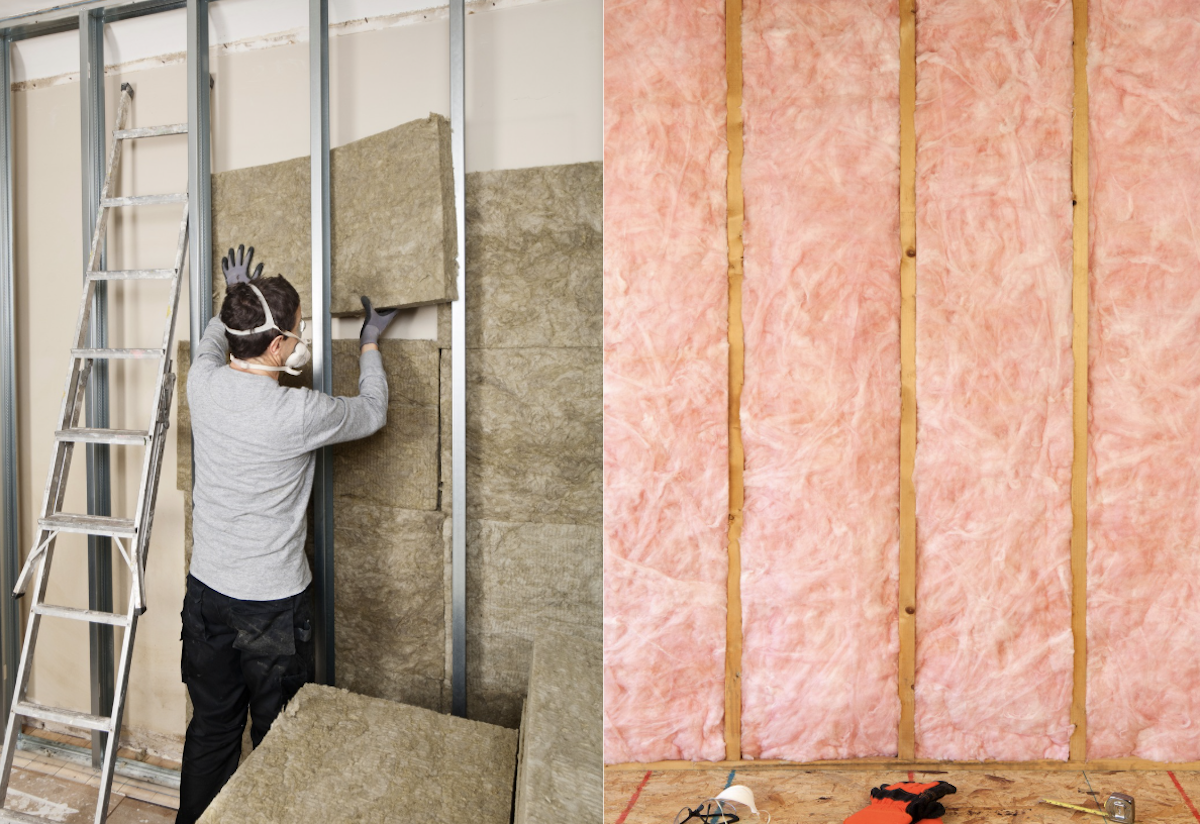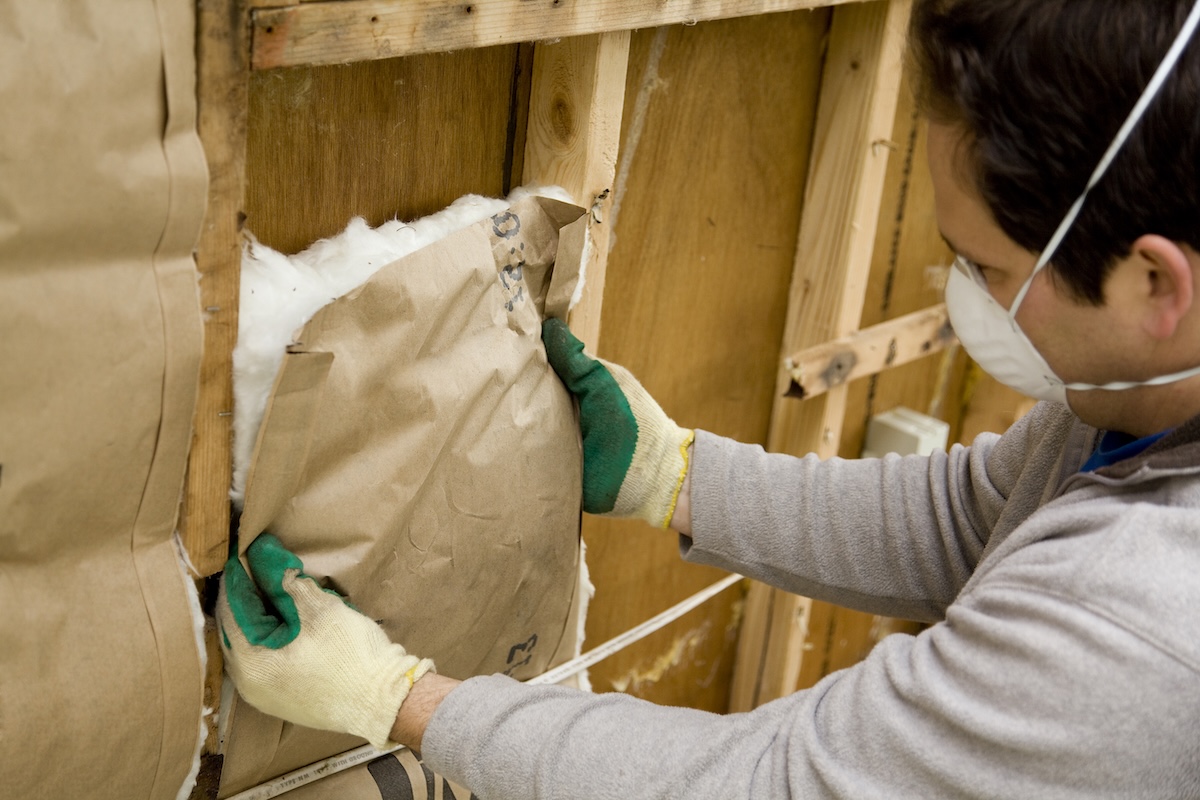

We may earn revenue from the products available on this page and participate in affiliate programs. Learn More ›
A house depends upon insulation to help regulate the flow of heat between its interior and the exterior. By slowing the transmission of heat through the building envelope—walls, floors, ceilings—a conditioned home can more easily remain warm in the winter and cool in the summer, despite the difference in temperature outdoors. A layer of insulation can also reduce noise transfer between spaces, and some insulation can also help block moisture from entering the home, which is a benefit in coastal regions and areas that get a lot of rain.
However, there are significant differences among various types of insulation and these differences impact whether faced vs. unfaced insulation is best. It’s important to know what type of insulation you are installing or replacing to ensure you select the best insulation for the home. Let’s break down the differences between faced vs unfaced insulation.
Faced Insulation

Insulation that has a covering on one side of itis called faced insulation. This type of insulation is usually used in perimeter walls because the paper or foil face acts as a vapor retarder, preventing mold and mildew. Faced insulation can be batts or rigid foam boards. Some faced insulation batts also have tabs along the sides that are used as a stapling surface to attach the insulation to studs.
When installing faced insulation, the paper or foil side faces the wall that’s warm during the winter months. So if you depend on the HVAC to heat your home during winter, the paper side will face the interior. However, faced insulation is not fire resistant. It is recommended for new wall construction.
Unfaced Insulation

Insulation that doesn’t have a paper face is unfaced insulation. Without the paper face, the insulation can have a fire rating and can be left exposed, if needed. Since it doesn’t have a vapor retarder included, it is designed for interior walls and is simply held in place by friction. It’s also a good choice when adding insulation during a remodeling project like between joists in an attic.
Differences Between Faced and Unfaced Insulation
Let’s take a quick look at the differences between unfaced vs faced insulation. Both faced and unfaced insulation are suitable choices for home insulation, but the differences between them help to determine the best locations within the home to install each type.
| Faced Insulation | Unfaced Insulation | |
| Has paper vapor retarder | x | |
| Easier to install | x | |
| Cheaper | x | |
| Fire rating | x | |
| Interior walls | x | |
| Exterior walls | X |
Faced insulation includes a paper vapor retarder.
The main difference between faced and unfaced insulation is that faced insulation typically has a paper vapor barrier or retarder attached to one side of the insulation. The purpose of the paper vapor barrier is to block moisture from permeating the walls and ceilings of the home. This is especially useful in humid locations, like coastal cities.
While paper facing is common for batts and rolls, some faced insulation uses vinyl or even light aluminum foil as a vapor barrier, in place of paper. These alternate materials, however, may not be approved for use in some areas, so be sure to check local regulations and building codes before choosing insulation for the home.
Unfaced insulation can have a fire rating.
Faced insulation has a flammable paper vapor barrier, so one of the benefits of using unfaced insulation is that it can be a noncombustible material. However, not all unfaced insulation is noncombustible. If choosing fiberglass, consider sheep’s wool, or mineral wool as the insulation, because these material can actually help reduce the chance of fire by providing a barrier between the interior wall and the exterior wall that slows the spread of flames or stops them entirely.
Sometimes the two types can work together. A layer of faced insulation can be used in the exterior walls and attic ceilings to prevent moisture from entering the home, while an unfaced insulation layer can be added—on the unfaced side—to improve the heat retention ability and reduce the risk of fire.
Pro tip: Always make sure that the vapor barrier is on the outside of the insulation stack instead of in the middle. If it’s between two insulation layers it can cause moisture to build up within the insulation, leading to mold and mildew.
Faced insulation is easier to install.
DIYers looking for a way to make home insulation easier choose kraft faced insulation over unfaced insulation because typically faced insulation is significantly easier to install. This is because the insulation is held together by the paper vapor barrier, allowing the faced insulation to be rolled, moved, and stapled without falling apart.
Unfaced insulation does not have the same cohesive strength, so it’s more susceptible to tearing during installation. Additionally, staples don’t work well with unfaced insulation, so the installer needs to rely on the insulation to ‘friction fit’ and cling to the studs or joists. Some installers add a plastic vapor barrier over unfaced insulation to both block out moisture and help secure the insulation into the target bay.
Unfaced insulation is slightly more affordable.
There is a minor cost difference between faced and unfaced insulation.
- Faced insulation costs about $0.50 to $2 per square foot.
- Unfaced insulation costs about $0.50 to $1.75 per square foot.
The modest increase in insulation cost shouldn’t impact minor upgrades, though if you need to insulate an entire home or even multiple properties, the price difference may affect your decision.
Using Faced Insulation in Your Climate

Since there is a vapor retarder on just one side of faced insulation, its placement can greatly impact the health of the building. If placed incorrectly, it can trap moisture within the home’s structure and lead to serious and expensive problems. Here’s an easy way to remember how to install faced insulation based on your climate.
Cold Climates
If you depend on heat during the winter months, even if you wear shorts or sundresses during a few summer months, your climate falls under the “cold” category when it comes to insulation needs. In cold climates, a vapor retarder or barrier must face the interior of the home. Many pros refer to this as the ‘warm-in-winter’ rule.
If you are adding insulation to increase R-value, it matters whether you have faced or unfaced insulation already installed and how it is installed. When you have unfaced insulation installed and you want to install faced insulation to create a vapor barrier, you can add a layer of faced insulation on top of this first layer of insulation. However, faced insulation cannot remain exposed due to its flammability, so you will need to install drywall or another type of surface over top.
Warm Climates
If you don’t heat your home, your climate is generally considered warm. In hotter and wetter zones, the vapor retarder or barrier must face the exterior of the home.
If you want to add unfaced insulation to already-installed faced insulation, the new layer of unfaced insulation can be stacked on top of this layer of faced insulation with the vapor barrier facing the exterior of the home.
In either type of climate, if you have a layer of unfaced insulation installed you can stack another layer of unfaced insulation without issue.
